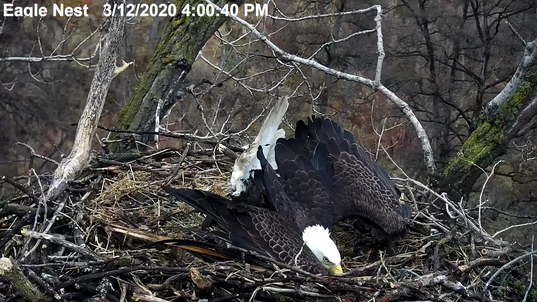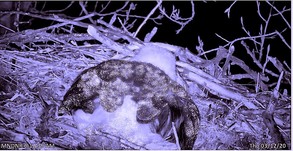|
March 13, 2020

Thursday wasn't exactly a great day to be expecting a chick. It was rainy and -- true to March's reputation -- very windy in St. Paul, Minnesota. Fortunately, our two eagles sit very tightly on their eggs. Over the past 35 days of incubation, we haven't seen them ever leave the eggs for more than a few minutes at a time. What responsible parents!
Those March winds can make you start to feel a little seasick if you watch the cam for too long! The nest and the camera are on different branches of the same tree, which is why you see so much motion. The eagles are not experiencing as much motion as it appears. The camera is moving around much more than the nest is.
Sill waiting
Because these two sit so tightly on those eggs, it makes it difficult to get a peek at the shells. Of course, we are looking for a pip (a small hole in the shell) soon, but we have not confirmed one yet. We are anxiously anticipating little fuzzy, wobbly heads any day now! Keep reading for insight about what is exactly going on inside of those eggs.

The rare glimpses we get of our eagles’ eggs may suggest not much is going on with them, but inside those white shells a host of physiological changes are or will soon be unfolding in what amounts to a 72-hour countdown to the hatch.
One of the main things that needs to happen is for the embryonic chick to switch from getting oxygen through the membrane that surrounds it in the egg to breathing on its own. First, a muscle at the nape of the chick’s neck swells and causes the head and beak to twitch and press against an inner membrane that eventually is pierced, allowing air to reach the chick. At this point it starts to actually breathe, and the chick’s parents may be able to hear faint chirping from inside the egg.
As the chick breathes and re-breathes the air inside the egg, carbon dioxide accumulates, causing more muscle spasms. A bony protuberance on the chick’s beak known as the “egg tooth” taps at the shell until a tiny, barely visible star forms, letting in some fresh air. With that, the chick usually calms down for a few hours before creating a larger, visible hole known as a “pip.” EagleCam watchers may recall seeing the pip, with a tiny beak visible inside, in years past.
With an opening to the outside, the chick’s lungs become fully functional, which triggers the little bird to start rotating inside its shell, industriously cutting around the egg’s circumference until a cap is loosened and the bird first lifts its fluffy head into view. The week or so after hatching tends to be one of the riskiest for chicks.
These three eggs were laid on February 6, 9 and 12, and incubation usually lasts about 35 days, so we’re all keeping our fingers crossed and hoping for a successful hatch soon!
|

Adjustments are always necessary in the technical world. Sometimes there are updates to software or hardware. If windows has an update, for instance, then everything else needs to adjust to update. As many of you know, when that happens, it creates a ripple effect. There are many moving parts to our camera and microphone, so again, we appreciate your patience when the image doesn't look quite right, or if the sound doesn't match the image. Feel free to send us a note, but for the most part, you can be sure we are working behind the scenes to keep things running beautifully. Speaking of beauty - take a look at the night vision of the incubating female. The combination of snowflakes on her back and the infra-red on the camera made her back appear to have diamonds on her back. Sometimes nature is simply magical, isn't it?
|
Visit the DNR EagleCam: mndnr.gov/eaglecam
|